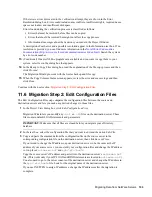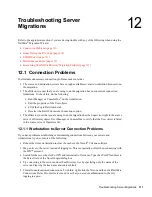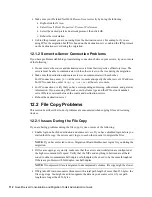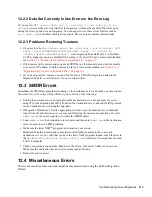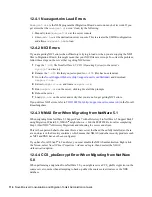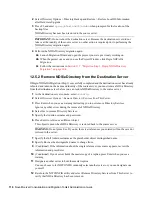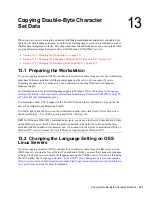
112
Novell Server Consolidation and Migration Toolkit Administration Guide
no
vd
ocx
(e
n)
6 Ap
ril 20
07
Make sure your Preferred NetWork Protocol is set correctly by doing the following:
Right-click the N icon.
Select
Novell Client Properties
>
Protocol Preferences
.
Select the desired preferred network protocol, then click
OK
.
Reboot the workstation.
Unbind the protocol you are not using from the destination server. For example, if you are
using IP for the migration but IPX is bound on the destination server, unbind the IPX protocol
on the destination server during the migration.
12.1.2 Server-to-Server Connection Problems
If you have problems establishing or maintaining connections between your servers, try one or more
of the following:
Do not remove the source and destination servers from their respective eDirectory trees. The
servers must be able to communicate with the other servers in the tree during the migration.
Make sure the destination and source servers can communicate with each other.
For IP connections, enter
ping
at the server console and specify the other server’s IP address.
For IPX connections, enter
display servers
at the server console.
For IP connections, verify that you have corresponding addressing, subnet mask, and gateway
information. If you are using IPX, make sure the frame type and the IPX network number/
server ID are consistent between the source and destination servers.
Reboot the destination server.
12.2 File Copy Problems
This section describes what to do if problems are encountered when copying files and restoring
trustees.
12.2.1 Issues During the File Copy
If you are having problems during the file copy, try one or more of the following:
Enable login on both the destination and source servers. If you have disabled login before you
started the file copy, the servers can’t log in to each other in order to migrate the files.
NOTE:
If you have selected to do so, Migration Wizard disables user logins for you during the
migration.
If files are copying very slowly, make sure that the servers and workstation are configured at
the highest common LAN speed. Verify that the NICs and anything in between are all hard
coded to either communicate half-duplex or full-duplex; they need to be the same throughout.
If there are problems with full-duplex, use half-duplex.
NOTE:
If compressed files are migrated to uncompressed volumes, file copy might be slower.
If Migration Wizard encounters filenames with a total path length of more than 256 bytes, the
file copy stops. You might need to reorganize the data on your source server if your path
lengths are longer than 256 bytes.
Summary of Contents for Server Consolidation and Migration Toolkit 1.2
Page 4: ...novdocx en 6 April 2007...






